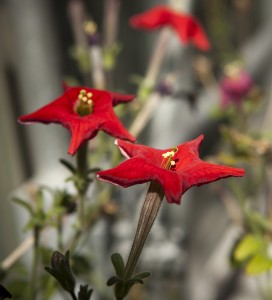Petunias Rare and Red
Posted in Around the Garden, Science on April 16 2012, by Matt Newman
 Off on a side table, just inside one of the treated glass superstructures of the Nolen Greenhouses for Living Collections, there stands a spray of stems headed with humble, star-shaped flowers. The aesthetic is nothing wildly exotic–a deep crimson defines the petals. The plant is otherwise unremarkable next to a common garden petunia. And yet the “DO NOT TOUCH” sign hand-written and jabbed in alongside the plant is evidence of its peculiar value. Is it fragile, or perhaps toxic?
Off on a side table, just inside one of the treated glass superstructures of the Nolen Greenhouses for Living Collections, there stands a spray of stems headed with humble, star-shaped flowers. The aesthetic is nothing wildly exotic–a deep crimson defines the petals. The plant is otherwise unremarkable next to a common garden petunia. And yet the “DO NOT TOUCH” sign hand-written and jabbed in alongside the plant is evidence of its peculiar value. Is it fragile, or perhaps toxic?
Neither in particular. This plant, Petunia exserta, is one of incredible rarity.
Its scarcity can be judged by the numbers. During an expedition in the summer of 2007 to the Serra do Sudeste region of southeast Brazil, a place noted for its variety of unique petunias, researchers left with an anemic total of 14. Just 14 living examples of this plant could be accounted for in the wild, living in the shade of sandstone towers. Fortunately, the NYBG has a cultivated specimen of its own for research purposes.
Beyond its rarity, P. exserta is an example of a flower which has evolved a very specific “pollinator syndrome.” The phrase sounds vaguely pathogenic. In plants, however, this refers to the species’ evolution in catering to a specific type of pollinator. You might remember Darwin’s star orchid, which Joyce Newman detailed not long ago–how the mystery of its continued pollination boiled down to a single, elusive species of moth feeding on the flowers after dark. The petunia is similar in that it targets hummingbirds, bursting forth with brightly-colored flowers that–strangely to some–offer no fragrance. This is owed to the fact that hummingbirds, like most bird species, have almost no sense of smell whatsoever. Combined with exserted (“thrust out”) stigmas full of rich nectar, each flower is custom-built to be a hummingbird bullseye.
Surprisingly, alongside encroachment by civilization and agriculture, one of the greatest threats to the remaining P. exserta plants in Brazil might not be what you expect. Instead, a cousin of exserta known as P. axillaris is pushing its red-flowered relative further toward the brink of extinction through–of all things–natural reproduction. The white, fragrant flowers of axillaris easily differentiate it from its relative, as does its preference for being pollinated by hungry hawkmoths. But the two species of petunia are so closely related that hybridization happens almost casually, leaving the underdog exserta to be bred out of existence.
The future of P. exserta in the wild is no doubt in question. But safe in its pot, growing with so many fellow rarities in the Nolen collections, our little holdout against the march of time is thriving. Scientists, meanwhile, study this rare red petunia with questions in mind. What gives it its color? What comes of its easy interbreeding with other species, and why fraternize with hummingbirds when nearby petunias choose otherwise? As a unique survivor on the brink, it stands to offer many answers

